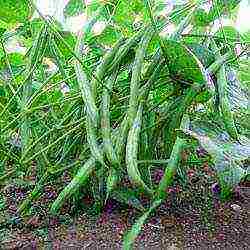Content
- 1 Views
- 2 Phlox mulching
- 3 Preparing for winter
- 4 Breeding methods
- 5 What you need to know about phlox breeding?
- 6 What does the plant love and what is it afraid of?
- 7 Dangers to phlox
- 8 Phlox in landscape design
- 9 Planting phlox in open ground
- 10 How to properly care for phlox
- 11 Description and characteristics of perennial phlox
- 12 Varietal variety
- 13 Reproduction methods
- 14 Landing
- 15 Care
- 16 Diseases and pests
- 17 Botanical description of the species
Paniculata phlox are one of the most popular perennials in our gardens. These flowers belong to the relatively small Sinyukhov family, consisting of 18 genera and 330 species. Representatives of the family are distributed almost all over the world. The phloxy genus consists of approximately 70 species, all of which are dicotyledonous spine-petalled perennials. The exception is Drummond's one-year phlox. In this article we will talk about paniculata phlox - how to plant in the garden, what kind of care to provide and how to propagate.
Botanical description of the species
Phlox paniculata (Phlox paniculata) is a perennial herb 35-150 cm tall. Most varieties form bushes with a height of 60-70 or 80-100 cm. It must be remembered that this parameter changes, depending on the light intensity. In the bright sun, the plants turn out lower, but even a two-hour midday shade increases their height. Stems are very strong, straight, woody by the end of the growing season.
There is no yellow in the phlox paniculata color palette. This pigment is also absent in the group of so-called red varieties. Their color is dominated by crimson color of different saturation, both warm and cold tones. Therefore, in the descriptions there are definitions such as red-pink, red-purple, light orange-red, purple-red, etc. The situation is similar in the group of orange, or salmon. These tones are very peculiar and complex, they also come in different intensities with the addition of pink and carmine.
Views
Varieties with white flowers:
- "Blue Ice" - a variety with white and pink flowers;
- "Europe" - white inflorescences have pink eyes;
- "Fujijama" - forms white inflorescences, collected in long inflorescences;
- "Graf Zeppelin" - white inflorescences with a red eye;
- "Mia Ruys" is a low variety with pure white flowers;
- "Mother of Pearl" - white inflorescences have a pink tint;
- "Pax" - it blooms snow-white;
- "Rembrandt" - creates large white inflorescences;
- White Admiral is a tall variety with white flowers.
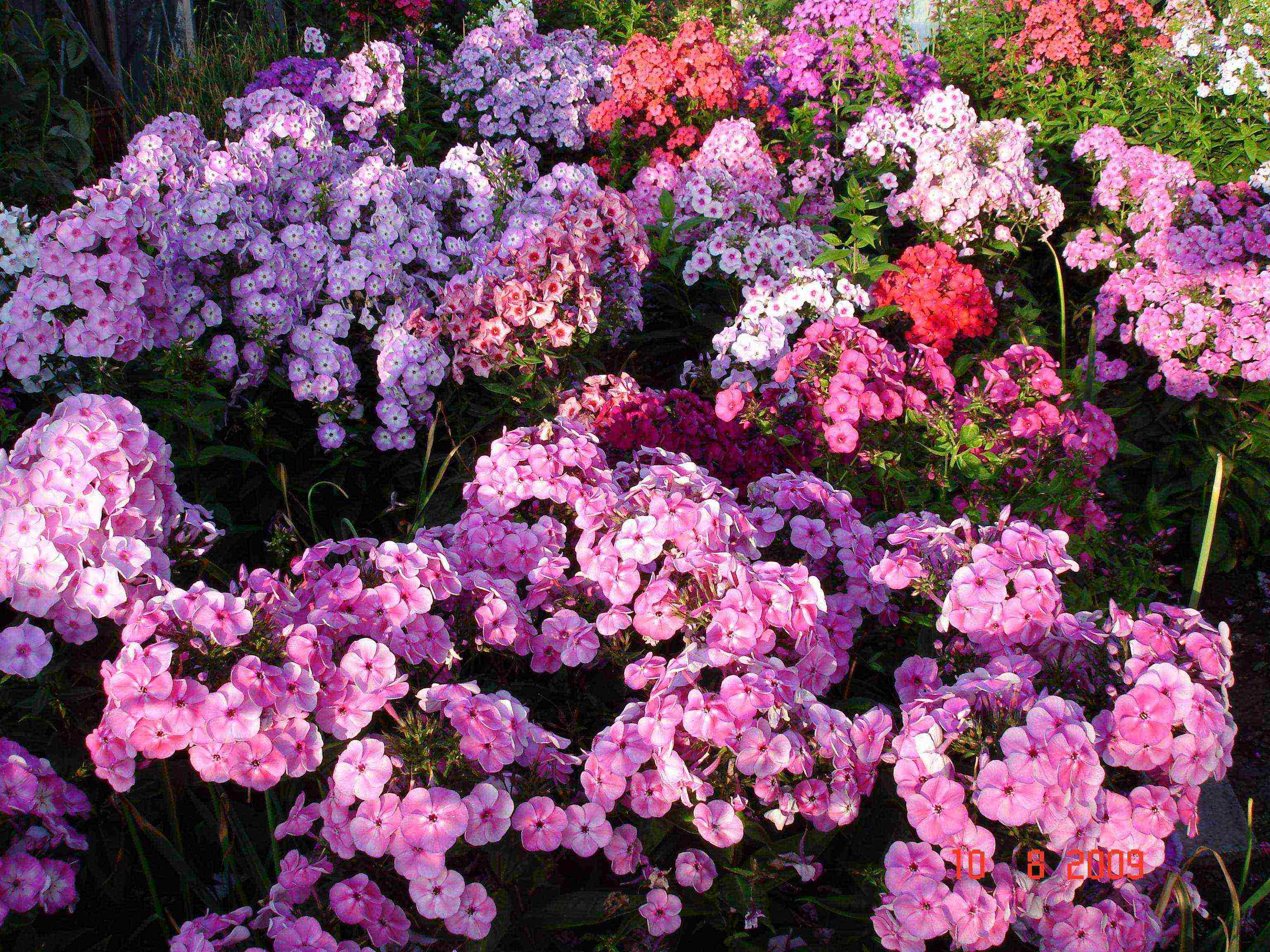
Varieties with red and pink flowers:
- Balmoral is a strong growing variety with pale pink flowers;
- Brigadier - pink-orange flowers;
- "Bright Eyes" - pale pink inflorescences have darker eyes;
- "Cecil Hanbury" - one of the undersized varieties, orange inflorescences with red eyes;
- "Flamingo" - pink inflorescences with red eyes;
- "Landhochzeit" - one of the highest varieties, pink-purple inflorescences;
- "Mies Copijn" - blooms in bright pink;
- "Prince of Orange" - pink inflorescences with an orange tint;
- "Rijnstroom" - forms intense pink inflorescences with bright large eyes;
- "San Antonio" - it blooms in red;
- "Sandringham" - pale inflorescences with darker eyes;
- "Starfire" - dark red flowers;
- "Tenor" - purple flowers;
- "Windsor" - has pink-red flowers with a burgundy center.

Varieties with purple and blue flowers:
- "Aida" - undersized variety, purple flowers with a purple eye;
- "Amethyst" is a tall perennial plant with purple flowers;
- "Blue Boy" - characterized by strong and intense growth, blue-violet flowers;
- "Blue Paradise" is a low-blooming blue variety;
- Border Gem - spectacular blue-violet flowers;
- "Dusterlohe" is a tall variety with deep purple flowers;
- "Eventide" - flowers have a bright, blue-violet color;
- Harlequin is a strong growing variety with purple flowers and colorful leaves;
- "Le Mahdi" - purple flowers turn pale in hot weather;
- "Norah Leigh" - has bright flowers and colorful leaves;
- "Prospero" is a tall variety with bright purple flowers;
- "Skylight" - purple flowers with dark eyes.
Planting phlox in open ground
When planting a plant, it is necessary to take into account the growing conditions of wild phlox. In nature, they are found in floodplains of rivers, on forest edges and meadows. The climate in which such plants are found is very humid and warm with mild winters. Also in the wild, phloxes choose organic-rich soil.
The first thing to do before planting flowers is to make sure that abundant watering is possible. The main problem of phlox is the constant lack of moisture. The second mandatory measure is the introduction of a sufficient amount of organic matter into the soil.
Important! Prepare the soil ahead of time. For spring planting, start preparing in the fall, and for autumn planting, start preparing the soil in the summer.
Planting of plants is carried out both in open areas and in slightly shaded areas. For flowers with dark colored petals, light shading is desirable, especially on a hot summer day. The site should have a slight slope, along which melt and rain water will flow down, without flooding the plants.
The best time to plant phlox is April. In conditions of high humidity and low temperatures, plants are better able to take root and take root in the area. It is most profitable to plant on a grid with a cell of 35 x 35 for low varieties and 50 x 50 for high ones, so they will receive a sufficient amount of nutrients. A perennial plant under the conditions of such a planting can live from 4 to 6 years.
How to properly care for phlox
Phlox loves moisture very much, its lack in the soil noticeably affects the well-being of plants. This is due to the structure of the root system, consisting of thin branching shoots located at a depth of only 15 cm. The soil under the plants must be moist all the time. With a lack of water, phloxes do not grow to varietal marks, the flowers become small, and the inflorescences are not so lush.
The irrigation rate is considered to be 15-20 l / sq. m. It is better to add water in the evening and always at the root. It is also important to loosen and mulch the soil after each watering. In addition to moisture, tall varieties of phlox require the installation of supports.
Advice! After watering, remove unwanted plants from beds and phlox beds. Weeds not only spoil the look of your garden, but are also a source of diseases for ornamental plants.
With the onset of frost, perennial phlox is pruned almost at the root. For the winter, they are wrapped or transferred to unheated greenhouses. If phloxes remain outside for the winter, then several crystals of copper sulfate are thrown into the middle of the bush. Annual varieties are removed from the site completely. Obsolete plants should be burned.
The soil is slightly acidic or neutral, sandy loam. Phloxes are responsive to fertile soils, therefore, when planting, you can add humus, ash or mineral fertilizers with nitrogen content. When planting, deepen the cut by 3-4 cm.
Watering.
Phloxes are moisture-loving, but do not like stagnant water. Often it is the waterlogging of these plants that leads to powdery mildew disease. When planting, make sure that there will be no stagnation of water in the spring after the snow melts. In the summer, watering at the root should be regular and abundant.
Top dressing.
Lush flowering of phlox is not so difficult to achieve using top dressing. It is recommended to feed three times a season at a strictly allotted time.The first time we feed phloxes in the spring during the regrowth of shoots with nitrogen-containing or complex fertilizers. The second feeding occurs at the beginning of summer during the budding period with complex or phosphorus-potassium fertilizers. And the final feeding with phosphorus-potassium minerals already without nitrogen is done after flowering, which prepares the plant for wintering. We use organic matter in the form of rotted compost, manure only in spring or when planting.
Phlox mulching
It is useful to mulch phlox for the winter. In central Russia, with a snow cover height of 50-60 cm, phloxes tolerate frosts well down to -20 ... -25 ° С. However, in very harsh and little snowy winters, plants can freeze out, especially foreign varieties.
In addition, every year the bush grows more and more. Together with it, its root system grows, and this happens in a rather peculiar way. A stem grows from the peephole and first stretches horizontally underground, then bends sharply and comes out to the surface. Under the ground, a knee is formed, which later becomes woody. Young roots begin to grow from it, and in the fall, new growth buds are laid on the same knee above the roots.
Thus, every year the rhizome grows in length by 1-3 cm and at the same time grows higher and higher. Finally, it begins to bulge out of the ground. Plants with such protruding rhizomes can die in winter, and shoots from buds that are too close to the surface or on old parts of the rhizome develop weak. The bush of the plant matures, matures, then begins to age.
The lignified parts of the rhizome in the center of the bush die off, simultaneously causing decay and death of the roots. In the end, the bush breaks up into separate parts, and the soil is depleted, which, in turn, leads to thickening of the plants, a decrease in flowering. To delay the aging process and protect the bushes from freezing in winter, it is advisable to mulch phlox annually.
Preparing for winter
Preparation of phlox paniculata for winter begins in autumn, this is one of the important stages, since the winter period is a serious test for many plants. After the plants have faded, potassium-phosphate fertilizers are applied, this enhances the root system and frost resistance. They also remove dried leaves and stems, sprinkle the bush with humus or peat, and then cover it with spruce branches on top. Such a shelter protects the plant from frost, and it calmly tolerates winter, and in summer it pleases with bright, beautiful flowering and green foliage.
Breeding methods
Reproduction of phlox paniculata is possible in several ways: The simplest and most affordable method is dividing the bush. Spring and early autumn are best suited for this, the bushes are divided into several parts, which consist of 2 - 3 thick stems. Propagation by cuttings is advised to be carried out in June, when the cuttings are still young and the flowering period has not come, after a month the cuttings root well and can be planted in a permanent place. When propagating by layering, the stem of the plant is attached to the ground and well spud with a mixture of peat and humus. Closer to autumn, an independent plant grows from the stem. To grow phlox from seed, stratified seeds are sown in boxes or pots. Then they are dived several times, preventing them from stretching too much, and transplanted into a greenhouse. They are planted in open ground in early May.
What you need to know about phlox breeding?
Speaking about the ways to promote the reproduction of these flowers, several can be distinguished. The simplest and most convenient method of reproduction is by dividing the bush. It should be used in spring and early autumn. It consists in the fact that the bush must be divided into parts, consisting of several thick and strong stems.
It is advisable to propagate the plant using cuttings in the first half of summer. June is the most suitable for this purpose. There is still no flowering period at this time of the year.It will be easy for young cuttings to take root. After a month, they can be transplanted to a permanent place.
Another popular method is layering. With it, the stems are attached to the soil and well spud using a mixture that includes humus with peat. By the onset of autumn, the pores will be able to find independent plants that have grown from such stems.
You can cultivate paniculata phlox using purchased seeds for these purposes. Stratified seeds should be preferred. It is advisable to plant them in a box or pot. Over time, it will be necessary to make a pick several times so that the plants do not stretch too much. After that, phloxes can be transplanted into a greenhouse. Transplanting plants into open ground conditions is possible in the first weeks of May.
What does the plant love and what is it afraid of?
This type of phlox prefers sunlight, with little shading, especially during the hottest time. It can grow in partial shade, but then the bush grows too tall, and does not bloom so abundantly and much later. Loves moderate moisture, it is hard to endure the dry period. Prefers rich fertilized soil, grows poorly on acidic. Phlox can be affected by powdery mildew, a variegated virus. Stem nematodes, which almost completely destroy the plant, are especially dangerous for the bush. To avoid this trouble, you should carefully monitor the quality of the soil and planting material. Without a doubt, paniculata phlox is one of the most attractive and cheerful flowers in any garden. It impresses with its unusual beauty and fragrant aroma. And with proper planting and proper care, it will delight with its lush flowering and bright colors all season.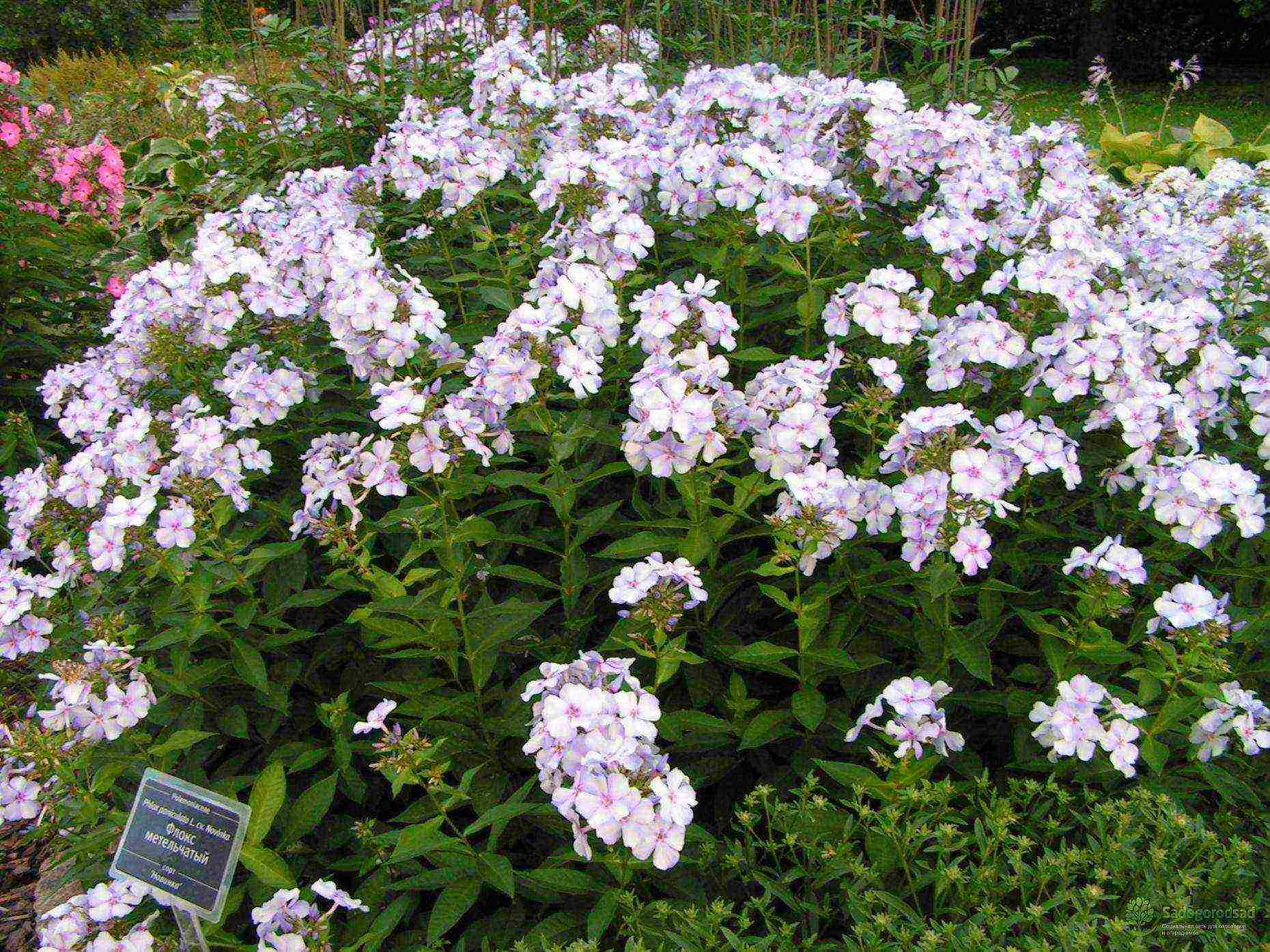
Dangers to phlox
The greatest danger to these magnificent plants is represented by diseases and pests. Among the first, powdery mildew should be highlighted, which occurs in the August days. It affects the lower, and eventually the upper, leaves of the plant, manifesting itself in the form of whitish specks. The spots grow over time, they become more and more. To avoid this scourge, timely prevention is necessary. This is the treatment of the bush using Bordeaux mixture.
Another disease that phloxes are prone to is the one called "ring spot". The disease can appear in late May and June. On the leaves of the plant, with it, light spots with a characteristic ring pattern may appear. In cases of severe infection, the leaves can be deformed, curled. At the same time, the plant refuses to bloom. Nematodes are carriers of this disease.
Among the pests that threaten the plant, microscopic worms called nematodes can be distinguished. They live in tissues and feed on plant sap. If severely affected by this pest, paniculata phlox may die. The affected bushes should be disposed of by burning them. The soil needs to be treated with nematicides. This procedure should be performed at least three times, adhering to a three-week interval.
Phlox in landscape design
Today this ornamental plant is actively used by masters of landscape design. The bushes fit perfectly into the front gardens and flower beds. When it comes to landscape applications, flowers are often found in alpine slides and rockeries. Phloxes look great in a single planting environment. Designers achieve an excellent color effect by combining different varieties of this plant.
Phlox is a real decoration used in garden design. A very fashionable solution is a monosad - floxarium. Most often, these flowers are combined with others, using them as a background. They are wonderfully combined with daylilies, garden geraniums, astilbe.
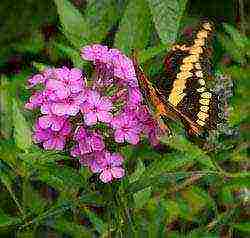 According to legend, the phlox appeared under a torch left by Odysseus, who emerged from the realm of the dead.Phlox bloom is very similar to a torch, and the brightness of flowers can easily be compared to the brightness of a flame. Growing any plant requires a certain investment of time and effort. What is one landing. Choose the right outdoor phlox care, and it will delight you with contrasting and rich colors throughout the season.
According to legend, the phlox appeared under a torch left by Odysseus, who emerged from the realm of the dead.Phlox bloom is very similar to a torch, and the brightness of flowers can easily be compared to the brightness of a flame. Growing any plant requires a certain investment of time and effort. What is one landing. Choose the right outdoor phlox care, and it will delight you with contrasting and rich colors throughout the season.
Description of the plant, its varieties and varieties
Phlox exists in nature mainly as a perennial plant, but there are also annual varieties. Flowers differ from each other in different ways, for example, in shape. Meet:
- cylindrical (Alexander, Hug, etc.);
- round (Babyface, Magic);

Babyface variety
- conical (Silver Age, Blue Paradise);
- pulus-shaped (Gaganov's favorite);
- umbrella-shaped (Seraphima, Apple blossom);
- pyramidal (Vrubel, Snow White).
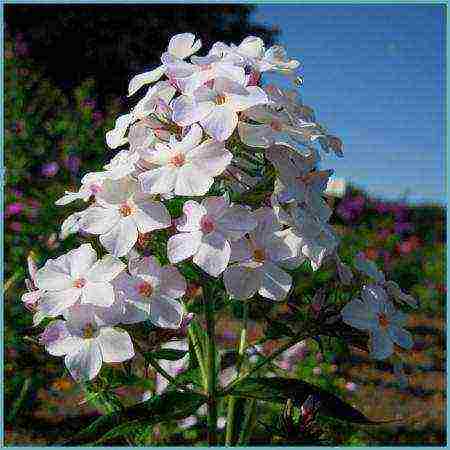
Snow White variety
Phlox is also divided by flowering time. A gardener can create a continuously blooming flower bed on his site. Having planted plants of different varieties on it:
- early phlox - bloom at the end of May, flowering continues until mid-July (Moskvichka, Groza, Arctic, etc.);
- medium phlox - flowering lasts from early July to late August (Africa, Aurora, Novinka, etc.);
- late phloxes - begin to bloom in August and end only after the first frost (Viking, Winter Merchen, Kirmensendler).

Variety Africa
The main difference between varieties of paniculate phlox is the color of the plant. The easiest way to sort them is by this principle.
White:
- Snow White - white flowers with a slight smoky pink tint, pink corolla tube;
- Europe - white flowers with a carmine eye;
- Knight - the flowers have a bluish tint, the petals are distinguished by a light wave along the edge.
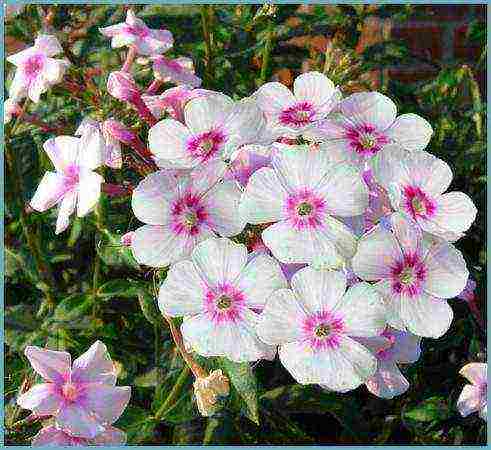
Variety Europe
Pink:
- Selena - a dark pink shade with a silvery smoky tint, a white star-shaped eye;
- Miss Pepper - the flowers have a light pink tone and a bright crimson ring.
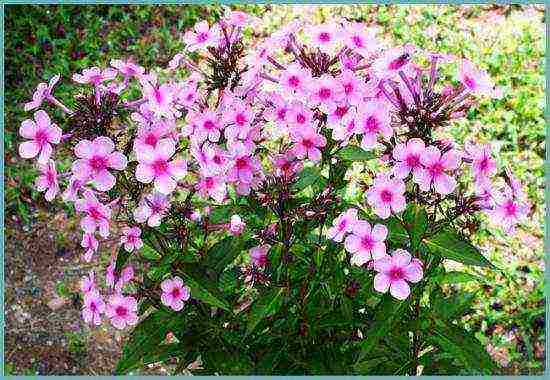
Miss Pepper variety
Red:
- Starfire - a dark rich red color emphasized by the velvety structure of the petals;
- Tenor - a red flower with a crimson tint;
- Seraphim - has fiery red petals.

Variety Tenor
Violet:
- Chernomor - blue-violet color of the petals, lightening towards the center, a dark eye in the evening changes its color from violet to blue;
- Cinderella is a beautiful light lilac shade with a crimson heart;
- Paradise blue - purple buds change color to bright blue at dusk.

Blue Paradise variety
In addition to the main colors, phloxes can be orange, salmon, blue, blue, purple, crimson. The range of shades of the buds of this plant has no boundaries. And a selection of photos proves this once again.
Planting phlox in open ground
When planting a plant, it is necessary to take into account the growing conditions of wild phlox. In nature, they are found in river floodplains, on forest edges and meadows. The climate in which such plants are found is very humid and warm with mild winters. Also in the wild, phloxes choose organic-rich soil.

It is very important to provide phlox with sufficient moisture.
The first thing to do before planting flowers is to make sure that abundant watering is possible. The main problem of phlox is the constant lack of moisture. The second mandatory measure is the introduction of a sufficient amount of organic matter into the soil.
Important! Prepare the soil ahead of time. For spring planting, start preparing in the fall, and for autumn planting, start preparing the soil in the summer.
Planting of plants is carried out both in open areas and in slightly shaded areas. For flowers with dark colored petals, light shading is desirable, especially on a hot summer day. The site should have a slight slope, along which melt and rain water will flow down, without flooding the plants.
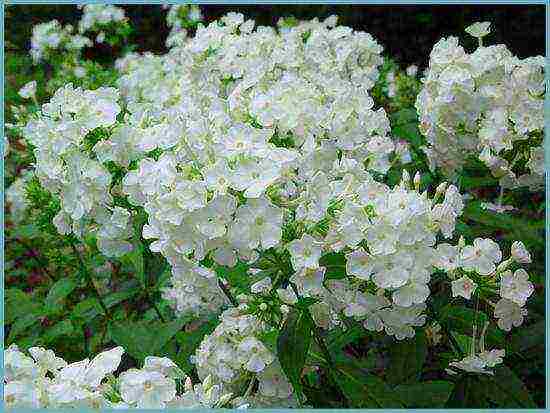
Phlox can be planted in light shade
The best time to plant phlox is April.In conditions of high humidity and low temperatures, plants are better able to take root and take root in the area. It is most profitable to plant on a grid with a cell of 35 x 35 for low varieties and 50 x 50 for high ones, so they will receive a sufficient amount of nutrients. A perennial plant under the conditions of such a planting can live from 4 to 6 years.
How to properly care for phlox
Phlox is very fond of moisture, its lack in the soil noticeably affects the well-being of plants. This is due to the structure of the root system, consisting of thin branching shoots located at a depth of only 15 cm. The soil under the plants must be moist all the time. With a lack of water, phloxes do not grow to varietal marks, the flowers become small, and the inflorescences are not so lush.

Water your plants in the evening when sun activity is low
The irrigation rate is considered to be 15-20 l / sq. m. It is better to add water in the evening and always at the root. It is also important to loosen and mulch the soil after each watering. In addition to moisture, tall varieties of phlox require the installation of supports.
Advice! After watering, remove unwanted plants from beds and phlox beds. Weeds not only spoil the look of your garden, but are also a source of diseases for ornamental plants.
With the onset of frost, perennial phlox is pruned almost at the root. For the winter, they are wrapped or transferred to unheated greenhouses. If phloxes remain outside for the winter, then several crystals of copper sulfate are thrown into the middle of the bush. Annual varieties are removed from the site completely. Obsolete plants should be burned.
Diseases to which phlox are susceptible
Phlox paniculata is also susceptible to some diseases. Planting and care, chosen correctly, can reduce the risk of contamination of plants with pathogenic bacteria, but this cannot completely eliminate the risk.

Powdery mildew on phlox leaves
- Rust. It appears in the middle of summer. On the leaves and stem of the plant, there are red-brown spots that look like rust. Subsequently, the number of spots increases, and the leaves are completely covered with them, the plant sheds the affected foliage, starting from the bottom, until it is completely bare. The fight against the disease is carried out by spraying the bushes and the soil around them with Bordeaux liquid and a solution of ferrous sulfate.
- Fomoz. This disease can be recognized by the presence of brown spots on the stem of the plant, which subsequently become loose and crust over and crack. The leaves turn yellow, dry out and fall off. Most often, plants are infected in the second and third year of life. Treatment of this disease practically does not bring success and it is better to remove infected plants, and take cuttings and planting material only from healthy phlox.
- Variegatedness. The most common disease among all phlox varieties. It appears at the moment when the plants begin to bloom actively. The disease can be identified by the presence of light-colored radial stripes chaotically covering the petals. The carriers of the causative agents of the disease are most often nematodes and other insects that feed on plant sap. If symptoms are found, phlox should be immediately dug up and burned, and the place where it grew should be disinfected.
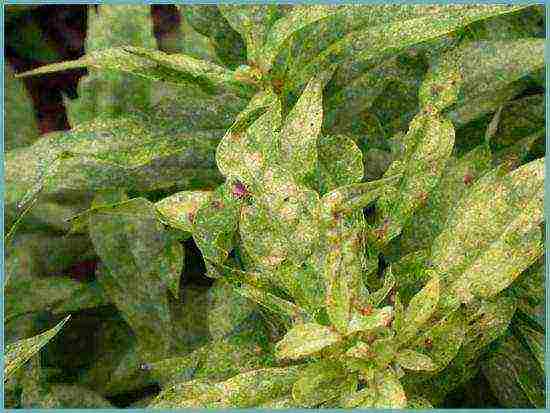
Phlox infested with bedbugs
Important! Pests love moisture as much as phlox. Mulching the soil will help protect flower beds not only from waterlogging and weeds, but also from some insects.
The main insect pests of phlox are nematodes, thrips and slugs. In the fight against them, it is necessary to treat both the plants and the soil under them at the planting stage. When dealing with slugs, it is best to use tobacco dust or wood ash.
The combination of phlox in flower beds and use in landscape design
Phloxes are famous for a wide variety of petal colors.Low-growing varieties are used by gardeners in decorating mixboards, alpine slides and flower beds. Phlox can become the main figure of a florist, or it can be planted in an auxiliary area of a large flower garden or rose garden.
Having picked up flowers in height and shade, the gardener can easily depict flowering figures on his site, and by combining with carpet plants, achieve a stunning effect in the design of the lawn near the reservoir.

Phlox in landscape design
Annual terry phloxes are used in the design of alpine slides and small garden beds. And as the photo shows, quite successfully.
The plant allows you to show all your creativity, thanks to the variety of colors and shades, as well as the growth difference of phlox. Growing them will turn into a long fascinating process, which, like painting a picture, will immerse the gardener in the world of bright colors.
Growing phlox paniculata: video
Phlox paniculata: photo


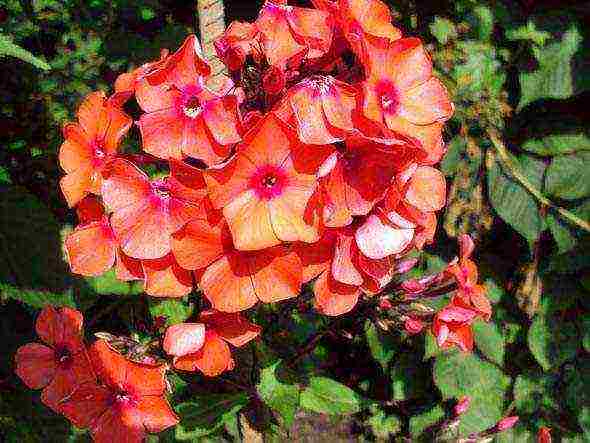





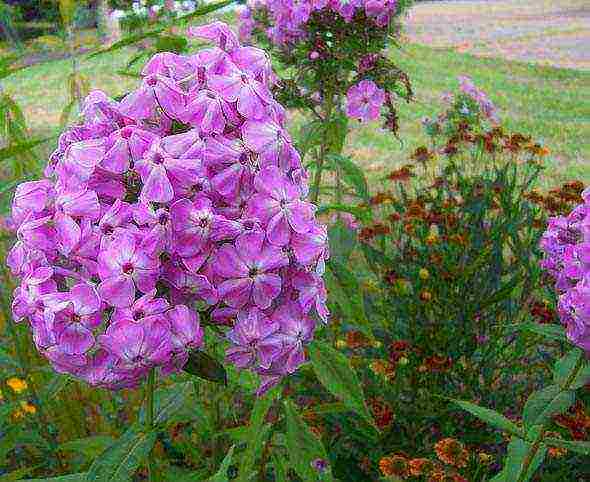
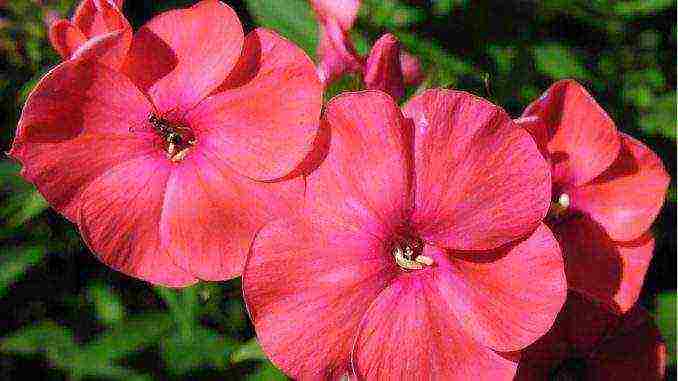
Perennial phlox is a lush flower with a bright aroma native to North America. The name of the flowers was given by Karl Linnaeus, it translated from Greek as flame... In culture, 40 species and more than 100 varieties of phlox are grown.
Description and characteristics of perennial phlox
The plant is a bush with straight stems and oval leaves. The height of the plant, depending on the species, ranges from 10 to 150 cm.
The stem ends in an inflorescence, which can contain up to 90 flowers. The tubular flower has five petals. The colors are varied, mainly pink, purple, blue shades are popular.
 Phlox color variety
Phlox color variety
After flowering, seed pods are formed.
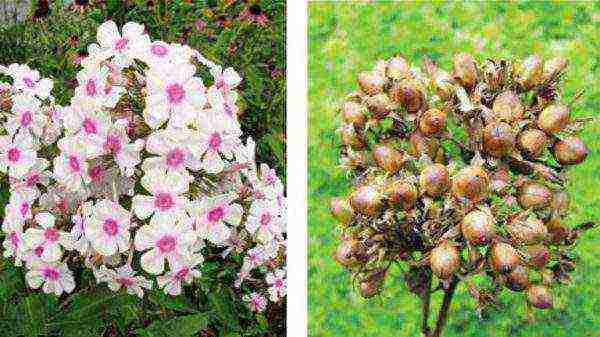 Mother plant and ripe seed pods
Mother plant and ripe seed pods
Varietal variety
Perennial phloxes can be divided into two large groups: ground cover and bush... Each group has its own species and varieties. In total, more than a hundred different varieties have been bred.
Groundcover
Low-growing flowers have a height of 10 to 40 cm. They are used in border compositions, alpine slides and balcony boxes. Types and varieties:
Subulate
It is named so because of the pointed shape of the leaves. Plant height 20 cm. It completely covers the flower bed with its bright flowers. It blooms twice - in May and August. Varieties:
- Mayshnee - white color;
- Tellaria - lilac petals;
- Thumbelina - pink color;
- Candy Stripes - pink petals with white edging.
Douglas
The stems of this species reach only 10 cm in height. Blooms from May to June. This species is also called "moss carnation" because the thick, crowded stems after flowering resemble forest moss.
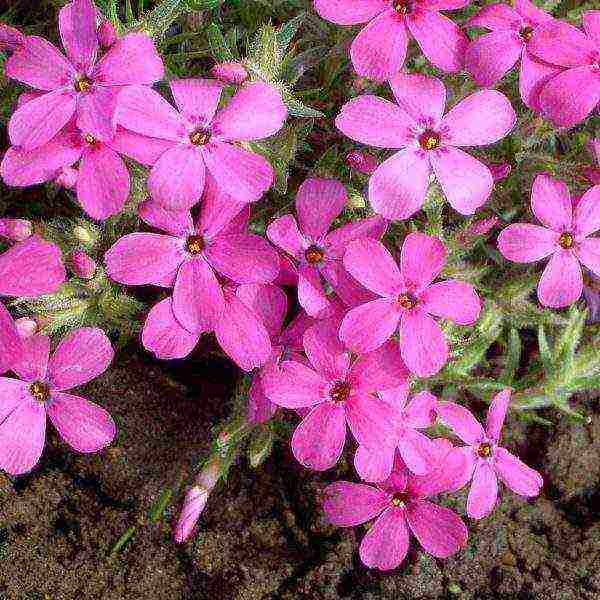 Phlox Douglas
Phlox Douglas
Forked
The stems are thick, the flowers are white or blue. The species is named so because of the shape of the petals. They bifurcate at the ends, giving the impression that there are twice as many of them.
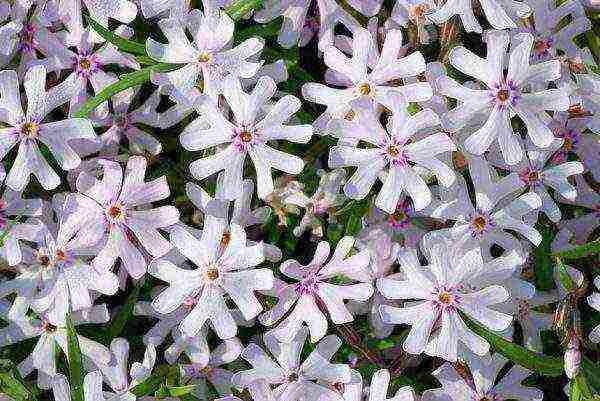 Phlox Forked
Phlox Forked
Bush
Bush phlox can be short and tall... This is the most common group of flowers that are grown in urban flower beds and gardeners' plots. The flowers are large, fragrant, bright saturated shades. The most common variety is paniculata phlox., it blooms in mid-summer and continues to bloom until autumn.
 A bright representative of paniculate phlox, cultivar Success
A bright representative of paniculate phlox, cultivar Success
Tall
- Windsor... Height 1.5 m. Grows best in sunny areas. The color is white and pink.
- Star of Paris... Blue flowers with thin lilac veins. Height 90-100 cm.
- Natasha... Petals in two colors - white and lilac. The height of the bush is 1.5 m.
- Larissa... The middle of the flower is purple, the edging is white, the edges are pink.
Undersized
- Delilah... Large purple flowers. Height 50-60 cm.
- Laura... The petals are lilac with a white center. Height 60-80 cm.
- Pet Mike... White petals with a pink center. Height 50-70 cm.
- Nicky... Velvety petals of deep purple color. Height 60-80 cm.
These are just some of the varieties that you will find in stores.Many more species have been bred by breeders, with various colors of the petals and the middle of the flower.
When choosing a variety, consider the place where you will plant it. The height of the bush and color should be chosen correctly to create an organic flower arrangement.
Reproduction methods
You can propagate these plants in three ways:
Seeds
They are harvested in the fall, when the leaves of the plant have already wilted. The ripe capsule is brown in color, the seeds in it are dark green. They are planted immediately after harvest, as they quickly lose their germination.
Seeds are sown directly into the ground at a permanent place. It is advisable to choose lighted areas, although some varieties are resistant to shading. The place must be protected from drafts... It is advisable to plant them in loose soil, phloxes do not like sandy and acidic soils.
Planting lasts from October to January. You can plant them when the snow has already fallen, you just need to clear the area from it. The distance between the seeds should be 5 cm. They are laid out on the soil, lightly sprinkled with earth and snow.
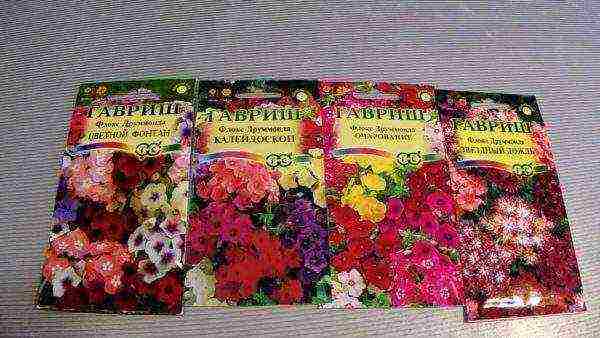 Phlox seeds
Phlox seeds
By cuttings
You can root cuttings in spring and autumn. With this method of reproduction, varietal characteristics are preserved even in rare phloxes.
In the spring, a mother bush is chosen, on which young shoots have reached a height of 15 cm. Selected shoots are cut and divided into cuttings of 5-7 cm. Each of them should have 1 pair of leaves. The sections are treated with a root stimulant.
The cuttings are rooted in a greenhouse or in a box. Mix equal parts of soil, humus and sand. The soil is watered, and a layer of river sand 2 cm thick is poured on top. Shoots are planted so that their lower edge is in the sand, does not touch the soil. Seedlings are covered with foil and sprayed regularly.
Rooting takes 3 weeks, after which the shoots are hardened and planted in a permanent place.
Cutting in the fall is carried out in a similar way. In early September, after flowering, the shoots of the current year are cut off. They are rooted in greenhouses according to the above scheme. In the spring they are planted in a permanent place.
Dividing the bush
This is the easiest way to reproduce. You can carry out the procedure at any time, except for flowering. You can divide the mother plant in the fourth year of life.
The bush is dug up and the shoots are cut to a height of 15 cm. With a knife or a shovel, it is divided into several new bushes so that each one has buds to resume growth. New bushes bloom next year.
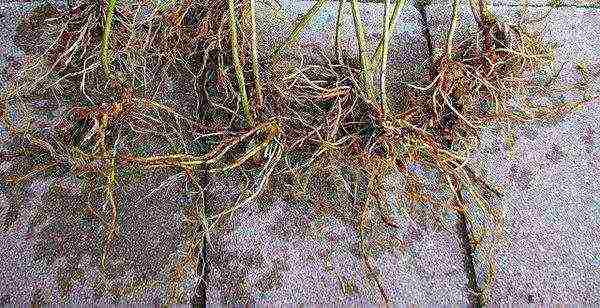 Split phlox bush
Split phlox bush
Landing
For lush flowering and rapid growth, phloxes need sunlight, loose nutritious soil, and protection from drafts. These plants are considered quite unpretentious, but it is best to prepare the site well before planting.
A year before planting the plant, it is advisable to fertilize the soil with organic matter: ash, manure, compost. Clay and heavy soils are best lightened with sand and peat. Sod, manure or compost should be added to sandy soils.
It is better to choose a sunny area near the fence, where there are no drafts. Shade-tolerant varieties can be planted under trees and bushes.
If you plant phloxes on the north side of the house, where there is no sun, their flowers will be small and scarce.
You should only buy cuttings and seeds from trusted locations. Before buying a seedling, pay attention to the root, it must have healthy buds, as well as 2-3 stems.
Seedlings can be planted outdoors in mid-April-May. After planting, they need to be watered abundantly; in summer, watering is reduced. Phlox is also planted in September before the onset of frost. They can bloom in the spring. In the summer, flowering seedlings are planted immediately. After planting, the peduncles are cut off, the bush is watered every day.
 Phlox seedlings
Phlox seedlings
When planting, keep the distance between plants. For low-growing varieties - 30 cm, for tall ones - 60 cm.
It is recommended to divide the bushes and replant them to a new location every 4 years.
Care
Unpretentious phloxes should be regularly watered and loosened, weeded and fed.You also need to pay attention to diseases in time and treat them.
Watering
This plant loves moisture. It is advisable to water it every 2-3 days. This should be done more frequently during dry summers. Along with watering, remove the weeds around the bushes and loosen the soil.
Top dressing
Fertilize the plant regularly to improve flowering. In the spring, during the period of active growth, nitrogen fertilizers are applied to the soil. During flowering, it is advisable to feed phlox with potassium or phosphorus preparations. In the fall, before frosts, the soil is fertilized with phosphorus agents. All dressings are carried out early in the morning or in the evening.
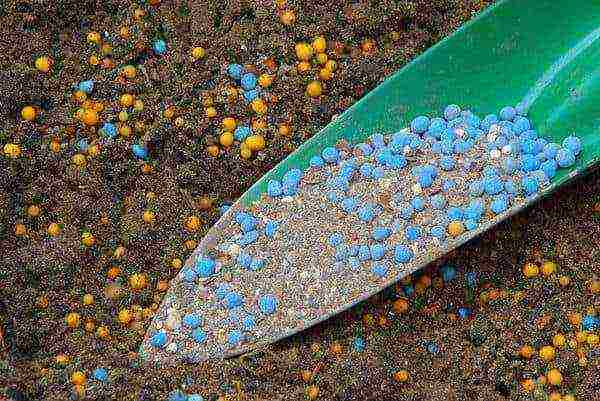 Fertilizing phlox
Fertilizing phlox
Preparing for winter
In the southern regions, no shelter for phlox is required. In central latitudes, it is advisable to shelter them for the winter. In autumn, with the onset of frost, withered stems are cut, the soil is mulched, the bushes are sprinkled with straw or covered with a special material. For the northern regions, it is recommended to dig up the bushes and store them in boxes in the basement.
Diseases and pests
Phloxes are affected by the same diseases as other garden plants:
- Fomoz... During flowering, the plant leaves turn yellow and curl, the stem turns brown and cracks. To combat the disease, the bushes are treated with Bordeaux liquid 4 times with an interval of 10 days.
- Powdery mildew... A white bloom appears on the leaves. To combat it, use Bordeaux liquid or other drugs. The affected leaves are removed. For prophylaxis in the spring, you can spray the shoots with potassium permanganate.
- Septoria... Gray spots with a brown border appear on the lower leaves. For treatment, the plant should be treated with the "Profit" preparation.
- Leaf spot... Yellow spots appear on the leaves. For treatment, remove the affected areas and spray the plant with a 1% solution of Bordeaux liquid.
The lower leaves of the plant may turn yellow and fall off due to lack of watering.
First, try to increase watering, if this does not help, then start treatment with drugs.
Most often, the following pests feed on parts of phlox:
- Slugs;
- Nematodes;
- Slobbering pennies.
Getting rid of them is difficult, so damaged bushes are dug up and burned. After that, the soil is carefully loosened and sprinkled with ash. The leaves can also serve as food for caterpillars and butterflies. To destroy them, you can buy any drug for gnawing pests.
Perennial phloxes are excellent plants for city flower beds and parks, for garden compositions, as well as for alpine slides... They perfectly coexist with other perennial flowers: roses, lilies, tulips, irises.
Paniculata phlox are one of the most popular perennials in our gardens. These flowers belong to the relatively small Sinyukhov family, consisting of 18 genera and 330 species. Representatives of the family are distributed almost all over the world. The phloxy genus consists of approximately 70 species, all of which are dicotyledonous spine-petalled perennials. The exception is Drummond's one-year phlox. In this article we will talk about paniculata phlox - how to plant in the garden, what kind of care to provide and how to propagate.
Content:
- Botanical description of the species
- Choosing a landing site
- Features of growing and care
- Reproduction of phlox
- Diseases and pests
Botanical description of the species
Phlox paniculata (Phlox paniculata) is a perennial herb 35-150 cm tall. Most varieties form bushes 60-70 or 80-100 cm high. It must be remembered that this parameter changes, depending on the intensity of light. In the bright sun, the plants turn out lower, but even a two-hour midday shade increases their height. Stems are very strong, straight, woody by the end of the growing season.
There is no yellow in the phlox paniculata color palette. This pigment is also absent in the group of so-called red varieties. Their color is dominated by crimson color of different saturation, both warm and cold tones.Therefore, in the descriptions there are definitions such as red-pink, red-purple, light orange-red, purple-red, etc. The situation is similar in the group of orange, or salmon. These tones are very peculiar and complex, they also come in different intensities with the addition of pink and carmine.
Choosing a landing site
When choosing a place for planting phlox, one should remember the growing conditions of their wild relatives. They are found in areas with a moderately warm and very humid climate, where there is often no snow in winter and the average temperature is around + 4 ° C. As a rule, these are meadows, river floodplains or forest edges, with loose, unheated by the sun, moist soils with a sufficient organic content.
One of the main requirements for planting phlox in the garden is the ability to water the plants abundantly. Even in places with a close occurrence of groundwater during a prolonged drought, phloxes suffer greatly from drying out. The second most important condition for their successful culture is sufficient soil fertility. Planting can be arranged both in open areas and in partial shade. The best will still be places under the protection of shrubs or rare trees with light shade during hot midday hours, especially for dark-colored varieties. In such places, snow accumulates better, and phloxes suffer less from sudden temperature fluctuations in winter.
It is desirable that the site has a slight slope, then during the period of snow melting and prolonged rains, the plants are not flooded with water. Slopes are unfavorable for planting, where the soil quickly overheats and dries out. In addition, here phloxes suffer from the wind, and in winter, when snow is blowing off the slope, they can freeze out. Areas under the crowns of trees with a superficial root system (birch, willow, poplar, spruce, old lilac bushes) are also not suitable.
A flower garden with phloxes can be arranged from the east, south-east, south-west and west sides of the house. Plants will feel worst of all near the northern wall and in the shade of conifers. They can live in such conditions, but it will be impossible to achieve full flowering.
This cold-hardy culture is also resistant to the harsh regions of northern Russia with short summers. Here, phloxes are placed in areas protected from cold winds and open from the southern, southeastern and southwestern sides, on raised heated flower beds, with a reliable winter shelter. Preference should be given to varieties with a shorter growing season, that is, early and early-middle, abandoning the middle-late and late ones.
In the conditions of the sharply continental climate of Siberia, Altai Territory, the Urals with cold, often little snowy winters, phloxes are planted in well-lit places protected from the wind with the greatest accumulation of snow. For the winter, it is necessary to cover it with peat, sheet or non-woven material in several layers. In such areas, it is also necessary to select varieties with earlier flowering dates.
In the southern regions, for planting phlox, the most humid areas protected from drying winds in light partial shade, near trees, wings of tall shrubs, buildings, and also near water bodies, should be allocated for planting phlox. Here, preference should be given to later varieties.
It is better to plant phloxes in open places, but so that in the hot midday hours the plants are shaded by rare trees and shrubs, which serve as both protection and from the drying effect of winds. The surface of the site should be flat, without depressions, with a slight slope for the drainage of excess melt and rain water.
Features of growing and care
Planting phlox
Phloxes achieve the best decorative effect on loose, well-filled with organic fertilizers, rather moist soils. With a lack of moisture, the concentration of salts in the soil increases, which adversely affects the development of plants: the lower leaves turn brown, dry out prematurely and fall off, the plants have a depressed appearance.Heavy clay soils are also unsuitable for phlox.
The soil should be prepared in advance: when planting plants in spring - in autumn, in autumn - in summer. First, you need to dig the ground to a depth of 20-25 cm, carefully select weeds (especially perennial ones). Then add organic fertilizers (manure, compost, peat compost - 1-2 buckets per 1 sq. M or 1/4 bucket of chicken manure), wood ash 100-200 g and mineral fertilizers. Fertilizers are embedded to a depth of 10-15 cm, since the bulk of phlox roots are located at a depth of 15 cm.
The best time for planting phlox is early spring (April-early May), since high soil moisture and relatively low air temperatures favor quick rooting of plants and better survival rate. Phlox can be planted in late August - early September. Timely and correct planting in the fall also ensures good rooting and abundant flowering next year.
In autumn, phloxes should be planted with stems, cutting off only their upper third, since without leaves, from which nutrients are supplied to the roots, plants will not be able to root well and lay growth buds on the rhizomes of the next year. The stems can only be cut after the ground has frozen and the leaves have been killed by the frost. As an exception, phlox can be transplanted in the summer, but at this planting time, plant growth is greatly delayed. Before digging, the bushes need to be watered, and when transplanting, keep the soil on the roots. It is better to divide the bush into large parts.
The feeding area for low-growing varieties of phlox is 35x35 cm, for tall varieties - 50x50 cm. With this planting, they grow in one place for 4-6 years. It should be planted in holes dug before planting and spilled with water. The root system must be loose. When planting, the roots must be straightened so that they are directed in different directions and slightly down. Having established a bush, cover the hole with earth, pressing the soil to the roots. It is necessary to deepen so that at the planted bush the top of the rhizome is 3-5 cm below the soil surface.
Phloxes are frost-resistant. They do not tolerate a lack of moisture, while flowering weakens, and the lower stem leaves turn yellow, dry up and disappear. Very responsive to mineral and organic fertilizers, light-requiring enough. They grow best in fertile, well-fertilized and well-drained soils.
How to fertilize phlox?
The introduction of top dressing during the growing season of plants should be carried out taking into account the phases of their development. As soon as the snow melts and the soil dries up, 20-30 g of ammonium nitrate, 30 g of superphosphate and 40-50 g of wood ash should be added under 2-3-year-old bushes, followed by embedding them into the soil with a hoe to a depth of 3-5 cm In the second half of May, it is necessary to make top dressing with fermented mullein infusion 1:15 (chicken droppings 1:25) or a solution of ammonium nitrate 15-20 g in 10 liters of water per 1 square meter. m. During the budding period of plants, apply the same fertilizers with the addition of 20-30 g of ash. At the beginning of flowering, feed with full mineral fertilizer: 20-30 g dry.
Fertilizers should be applied under the base of the bush; before and after applying liquid top dressing, the soil must be watered. Dry fertilizer should not be sprinkled on the leaves to avoid burns. Watering the bushes (once a summer) with microelements is very beneficial: 2-3 g of boric acid and 0.1-0.2 g of potassium permanganate (10 liters per 1 sq. M).
Proper watering is important
Correct planting and regular feeding will not be successful if phloxes do not have enough water. The bushes should be watered so that the soil is moist all the time. Phlox have a powerful root system, consisting of thin branching roots, the bulk of which are located at a depth of 15 cm. Therefore, they are especially sensitive to lack of water.
In addition, in the process of growth, phloxes develop such a mass of leaves, stems and flowers that they consume a large amount of moisture.Without watering, the stems of phlox grow low, inflorescences are formed less and the flowers become smaller, flowering occurs earlier and ends quickly. The lower leaves turn yellow and dry out.
In hot dry weather, water should be done so that the water soaks the entire root layer. Irrigation rate - 15-20 liters of water per sq. m. It is better to spend it in the evening, and after each watering or rain, the soil under the bushes must be loosened and mulched.
Keep in mind that weeds not only make your flower garden look unkempt, but also serve as a refuge for pests and diseases, so weeding is indispensable.
Pay attention to tall varieties of phlox: some of them have unstable stems, so they need to be tied to supports. In autumn, with the onset of frost, the stems of phlox are cut off at the very surface of the earth. It is advisable to burn the cut stems or remove them from the site. If phloxes are covered for the winter, then before that, for the prevention of diseases, it is advisable to throw a few crystals of copper sulfate in the middle of the bush.
Phlox mulching
It is useful to mulch phlox for the winter. In central Russia, with a snow cover height of 50-60 cm, phloxes tolerate frosts well down to -20 ... -25 ° С. However, in very harsh and little snowy winters, plants can freeze out, especially foreign varieties.
In addition, every year the bush grows more and more. Together with it, its root system grows, and this happens in a rather peculiar way. A stem grows from the peephole and first stretches horizontally underground, then bends sharply and comes out to the surface. Under the ground, a knee is formed, which later becomes woody. Young roots begin to grow from it, and in the fall, new growth buds are laid on the same knee above the roots.
Thus, every year the rhizome grows in length by 1-3 cm and at the same time grows higher and higher. Finally, it begins to bulge out of the ground. Plants with such protruding rhizomes can die in winter, and the shoots from buds that are too close to the surface or on old parts of the rhizome develop weak. The bush of the plant matures, matures, then begins to age.
The lignified parts of the rhizome in the center of the bush die off, simultaneously causing decay and death of the roots. In the end, the bush breaks up into separate parts, and the soil is depleted, which, in turn, leads to thickening of the plants, a decrease in flowering. To delay the aging process and protect the bushes from freezing in winter, it is advisable to mulch phlox annually.
Varietal phlox can be propagated by dividing bushes, stem and leaf cuttings, spring shoots, summer-autumn axillary shoots, root cuttings.
Phlox bushes are divided in early spring or early autumn (at this time, the bushes should be divided into larger parts). The dug bush must be shaken off or washed from the ground and separated by hands: first, precisely separate the plexus of the root necks, then disassemble the roots going to them. The knife should be used only when it is not possible to divide the rhizome with your hands, and you only need to cut it with a knife where the root necks grow together. Each separated part should have growth buds - “eyes” or shoot rudiments and a small number of roots.
Reproduction of phlox by stem cuttings can be carried out from the end of May to the 2nd half of July. For cuttings, take green, well-developed stems from healthy plants. Each stalk should have 2 knots, with the bottom cut just below the bottom knot, and the top one 5-10 cm above the top knot. Cut off the lower leaves completely, keeping the axillary buds. Plant the cuttings in shade, deepening them into the soil approximately to the upper node. For the first week, cuttings should be watered with warm water several times a day, making sure that they do not wither.
When propagated by leaf cuttings, an axillary bud with a leaf is used.In the summer, during the period of full development of the phlox stems, a shield 8-10 cm long with an axillary bud and a leaf is cut from their middle part with a sharp knife or razor. When planting, the flap must be placed vertically, deepening the axillary bud by 1.5 cm, cut off large leaves by 1/3. The plantings should be sprayed with warm water and the boxes should be covered with glass, placed in a room with a temperature of 25 ... 30 ° C. The sand must be constantly wet. By autumn, a plant with one stem is formed from a leafy cutting. For the winter, it is recommended to put boxes in a cold greenhouse, insulating it from above. In the spring of next year, rooted cuttings can be planted in open ground.
Reproduction of phlox by spring growth shoots is a type of propagation by stem cuttings. Growth shoots can be taken from heavily thickened bushes, carefully breaking them out at the very base with a “heel”. For better rooting, shoots should be planted in a warm greenhouse or greenhouse - they do not take root for a long time in the open field. You need to water it with warm water. In the second half of May and early June, rooted shoots can be planted in open ground.
Summer-autumn axillary shoots propagate phlox in the same way as spring growth shoots. It is necessary to use shoots growing in the leaf axils.
Reproduction of phlox by root cuttings can be carried out in early spring. At this time, the bushes are divided, from which you can take up to 1/3 of the roots and use them for cuttings.
For this, non-lignified, healthy, thick and long roots are suitable. They need to be cut off at the very base of the rhizome, cut into pieces 3-5 cm long and planted obliquely in exploration boxes filled with nutritious soil. First, the boxes should be placed in a room with a temperature of 10 ... 15 ° C, after 10-15 days they should be rearranged to another room with a temperature of 18-25 ° C and kept in shade.
When the shoots appear, the shading should be removed and the plants should be gradually accustomed to light, and then transplanted into open ground. Sprouts do not appear on all root cuttings, and they develop unevenly, therefore, plants should be planted in open ground selectively, as the sprouts grow. This method of propagation is especially valuable when the plants are infected with stem nematode, but it is necessary to preserve the variety.
Diseases and pests of phlox
Rattle
Light spots develop on the leaves; they spread along the leaf blade, later fade and necrotic. Sometimes only growth retardation is observed: some varieties are latent (hidden) virus carriers.
The disease is caused by the tobacco rattle or kinky virus. In addition to phlox, it affects aster, gerbera, hyacinth, gladiolus, crocus, lily, daffodil, peony, primrose, tulip, cineraria. The size of viral particles is 190X22 and 45-110X22 nm. It is carried by nematodes of the genus Trichodorus. Rattle is common in Central Europe.
Rugosity
The leaves become lumpy, curly, necrotic spots of irregular shape appear on them, glossy or covered with scabs. The veins turn brown, then die off. In other cases, a blackish bordering or yellow-green mosaic pattern develops. The growth of the stems is delayed, they are slightly curved and covered with single necrotic stripes or scabs. The internodes are shortened, the plant is compact, bushy by habit. Flowering is not observed or it is scarce. Often, affected phloxes dry out and die. The disease is caused by the tobacco necrosis virus, the virions of which are spherical, 26 nm in diameter. It is spread by a soil fungus (Olpidium brassicae).
Ring spot
The disease manifests itself at the beginning of the growing season of plants, the symptoms are most clearly visible in May-June. On the leaves of phlox, chlorotic light spots and a characteristic ring pattern are formed. On the leaf blades of individual shoots, areas of yellow color, of different sizes and shapes, are noticeable.In case of severe damage, the mosaic pattern covers the entire plant, it looks stunted and does not bloom. Leaves curl and deform.
The causative agent of annular spotting is the black annulus virus of tomatoes. Viral particles are spherical, 28-30 nm in diameter. It is transmitted by nematodes of the genus Longidorus (Longidorus).
Necrotic spotting
At the beginning of leaf blooming, dark brown, rounded necrotic spots 1–2.5 mm in size are observed on them, sometimes they completely cover the leaf blade.
Threadiness of leaves
In diseased plants, leaf blades are narrow, sometimes filiform, with wavy edges. Dwarf bushes, fragile shoots, flowering, as a rule, does not happen.
Variegated
Light strokes are visible on the petals; with severe damage to the inflorescences, the color becomes lighter than this is typical for this variety. It has been established that the disease is caused by the rash mosaic virus. This pathogen has a wide range of host plants and from flower crops affects carnation, cactus, delphinium, and tulip. The virions are spherical, 30 mm in diameter. Transmitted by nematodes of the genus Xiphinema.
Control measures
First of all, careful and timely culling of affected plants is necessary. It is unacceptable to take cuttings from diseased bushes. It is necessary to remove weeds, both in phlox plantings and in the vicinity of them. This prevents the transfer of infection from weeds to phlox.
Before planting phlox in new areas, it is necessary to analyze the soil for contamination with nematodes - carriers of phytopathogenic viruses (xyphinems, longidorus, trichodorus). If nematodes are found, the site is treated with a 0.2% metaphos solution.
